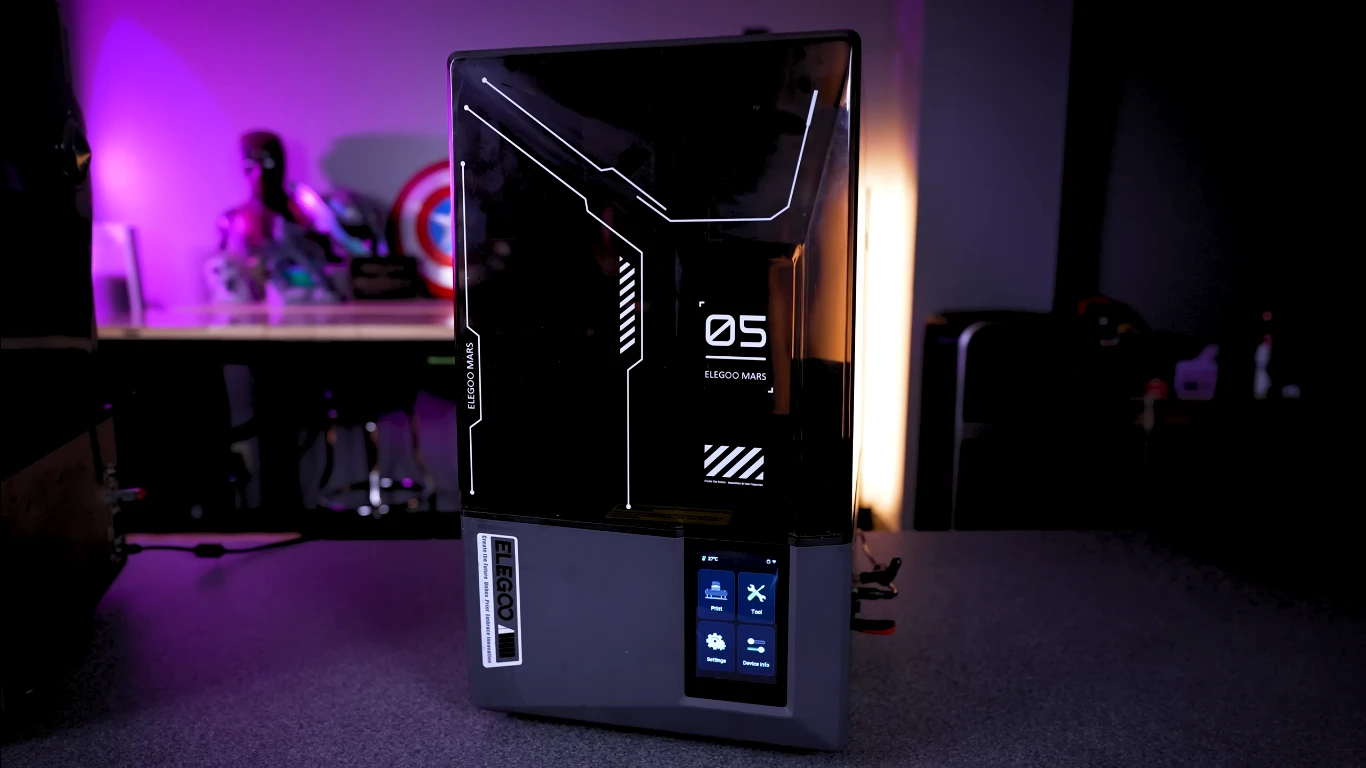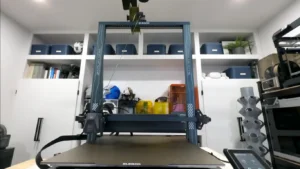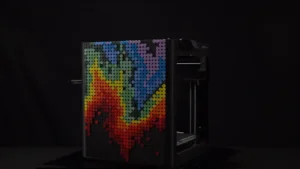The Elegoo Mars 5 Ultra sits at an interesting crossroads in the resin 3D printing world. At $269.99 (currently on sale from $338), it’s positioned between entry-level printers and more advanced machines, promising high-end features like 9K resolution and AI-powered monitoring in a compact package. I have just spent several weeks testing this printer in my workshop, printing everything from fine miniatures to strong parts and have a good idea of where this machine performs admirably as well as its limitations.
The Elegoo Mars 5 Ultra represents Elegoo’s latest attempt to bridge the gap between beginner-friendly features and professional-grade quality. With innovations like its tilting vat mechanism and AI camera monitoring system, it’s clear Elegoo is pushing boundaries in the sub-$300 price range. Of course, as we all know too well features in a spec sheet does not always pull through to the real-life performance. Let’s see how my experience was with this printer and whether it deserves all the praise.
Elegoo Saturn 4 Ultra Pro
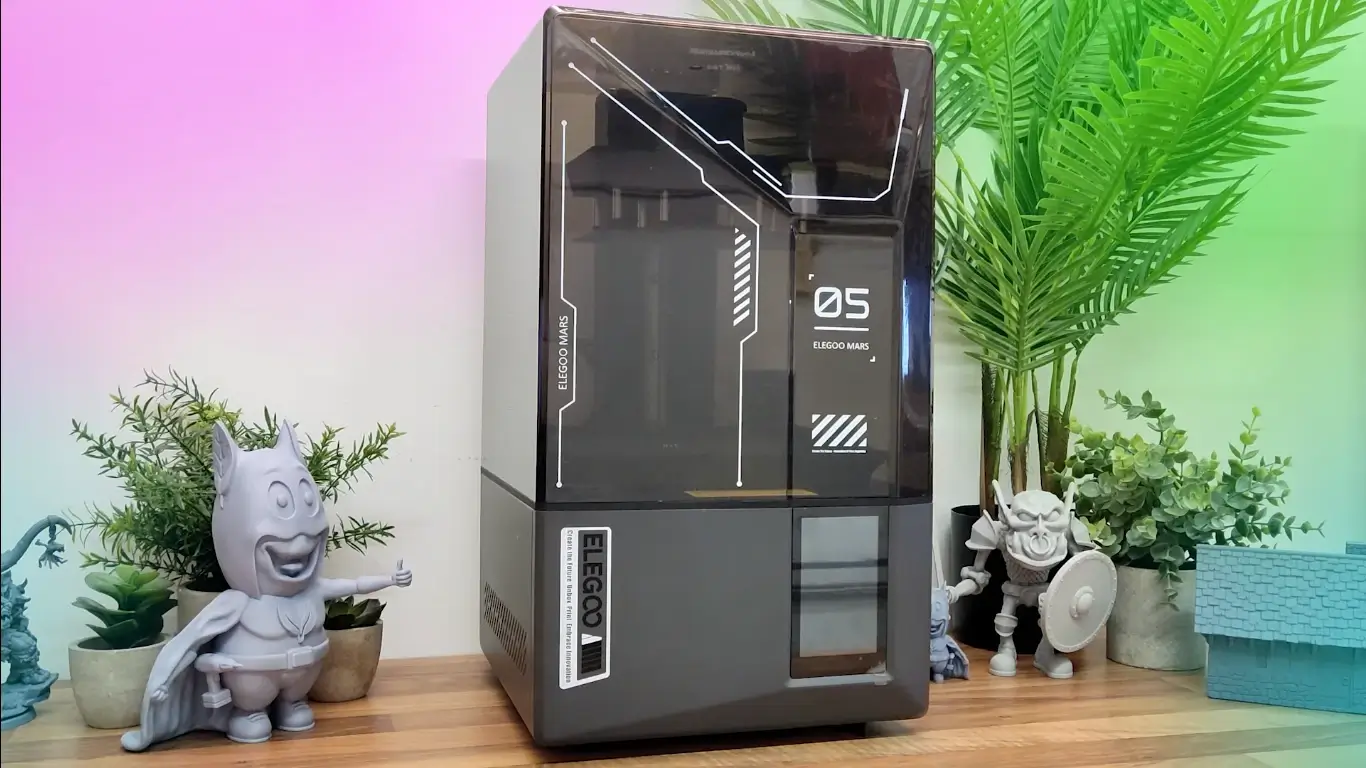
Pros
Fast print speed (2s/layer)
High-res 9K screen
AI print monitoring
Auto-leveling feature
Tilting vat mechanism
Cons
Small build volume
No integrated heater
Resin gets trapped in plate
No built-in filtration
Limited camera view
The Unboxing Experience
From the moment I pulled the Elegoo Mars 5 Ultra from its box, it was clear Elegoo wasn’t cutting corners on packaging. Everything was meticulously secured with foam inserts – something I always appreciate given how delicate 3D printers can be during shipping. The printer came with all the essentials: a power cord, build plate, resin vat, basic toolkit, and even some safety gear like gloves and a mask. What caught my eye immediately was the included AI camera module and WiFi antenna, features you typically don’t see at this price point.
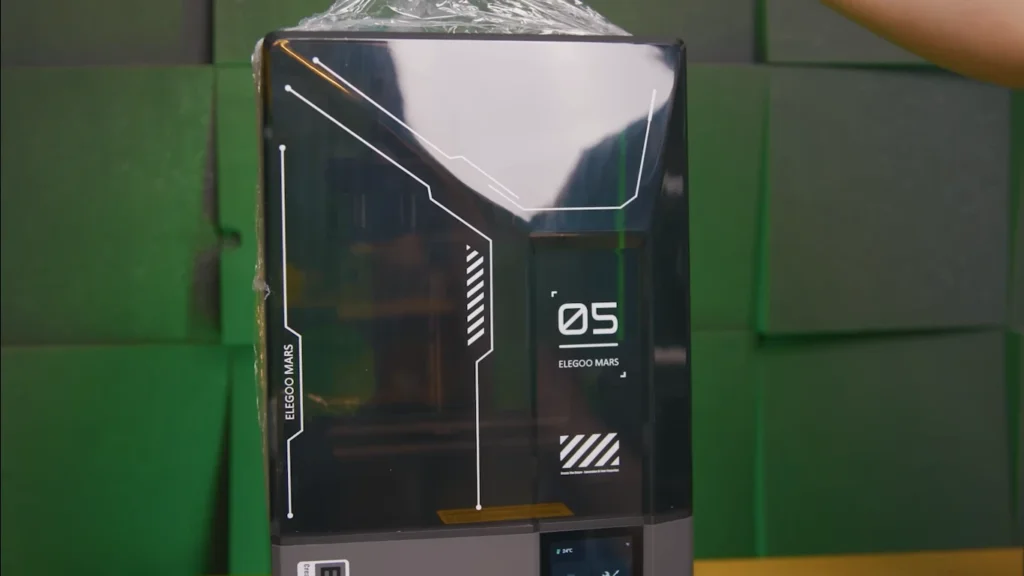
Setting up the printer took me less than 10 minutes, which is remarkable for a resin printer. Gone are the days of tedious manual leveling – the Elegoo Mars 5 Ultra handles that automatically with its smart mechanical sensor. I just removed the protective films, attached the build plate and vat, and was ready to go after a quick diagnostic test.
The Hardware That Makes It Tick
The Elegoo Mars 5 Ultra’s build volume of 153.36 x 77.76 x 165mm might seem modest compared to larger printers, but I found it perfect for my typical prints – miniatures, small functional parts, and jewelry prototypes. The real star of the show is the 7-inch mono LCD screen, boasting a 9K resolution (8520 x 4320 pixels) with an 18-micron XY resolution. In practical terms, this means you can achieve incredibly fine details that I could barely see without magnification.
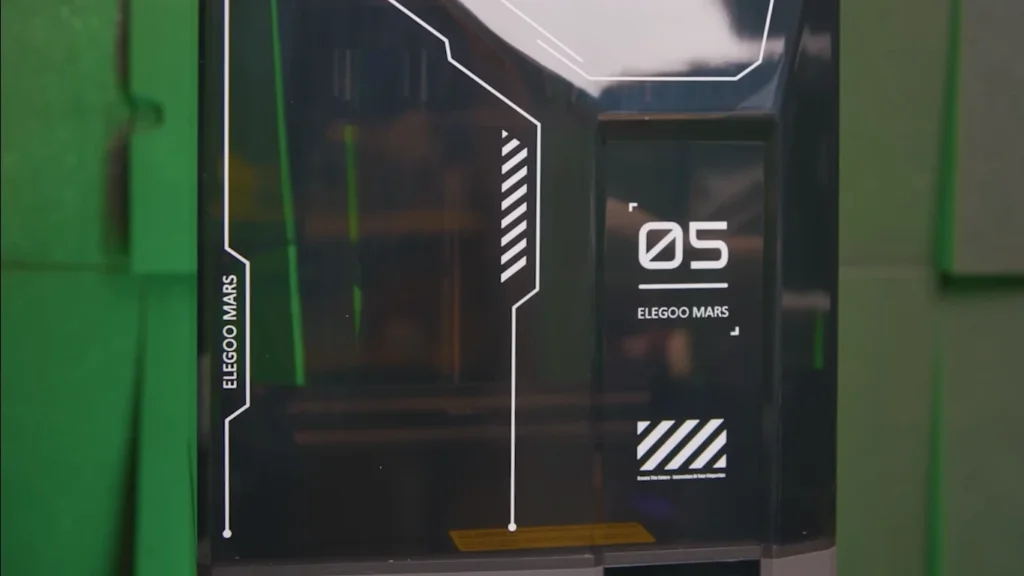
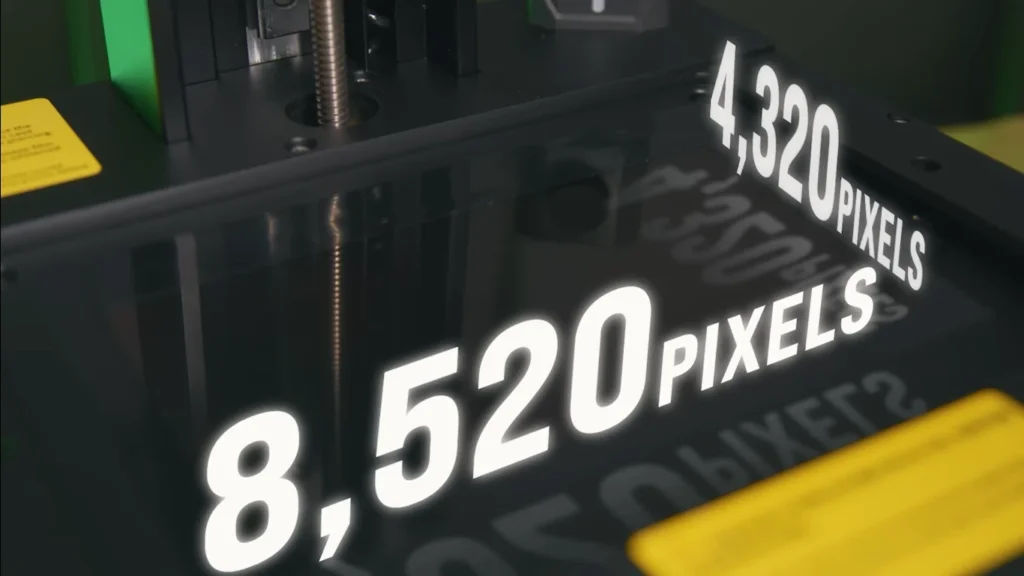
What really sets this printer apart is its tilting vat mechanism. Instead of the traditional approach where the build plate lifts straight up, the Elegoo Mars 5 Ultra tilts the entire resin vat. During my testing, this proved to be more than just marketing hype – it genuinely speeds up printing by reducing the forces needed to separate each layer from the FEP film. I managed to get layer times down to about 2-3 seconds, which is impressive for a printer in this class.
The Smart Features That Actually Work
I’ve tested plenty of 3D printers with “smart” features that ended up being more gimmick than useful, but the Elegoo Mars 5 Ultra’s AI capabilities actually delivered. The built-in camera isn’t just for show – it actively monitors prints for common issues like resin shortages or model warping. During one of my longer prints, it caught a potential failure before it ruined the entire model, saving me both time and resin.
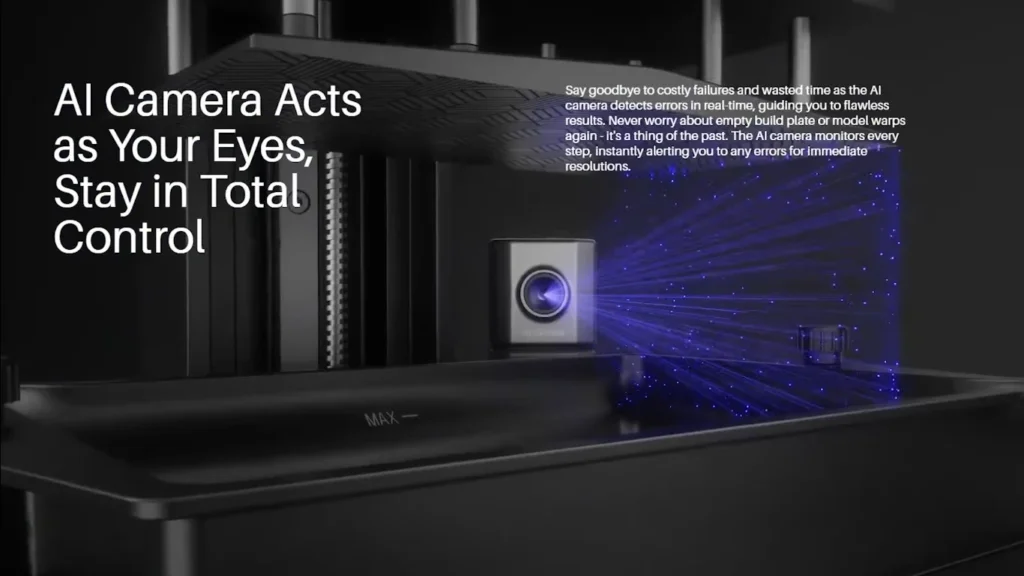
The printer’s interface is displayed on a 4-inch capacitive touchscreen that’s responsive and intuitive. While the portrait orientation takes some getting used to, I found the menus well-organized and easy to navigate. The added WiFi connectivity meant I could monitor prints from my phone and even start new prints remotely, though I’d recommend being nearby when starting any resin print.
Print Quality and Performance
I put the Elegoo Mars 5 Ultra through its paces with a variety of prints, from highly detailed miniatures to functional parts with complex geometries. The results consistently impressed me. The 18-micron pixel size means layer lines are barely visible, and the anti-aliasing implementation in the latest ChituBox software does a great job of smoothing out any remaining artifacts.

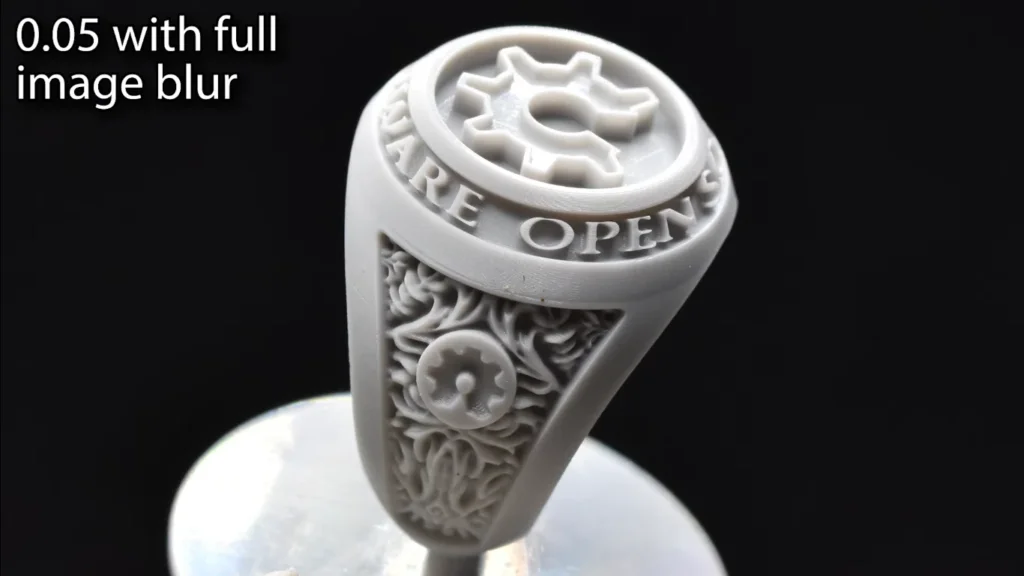
The printer advertises speeds up to 150mm/h, though in real-world testing with standard resins, I found myself printing comfortably at around 40mm/h with 50-micron layers. Even at these more conservative speeds, I was able to print a full plate of 32mm miniatures in under 90 minutes – significantly faster than my older resin printers.
One feature I particularly appreciated was the section-based exposure test, which lets you dial in your resin settings quickly. Instead of printing multiple calibration models, you can test different exposure times in one go. This saved me countless hours of trial and error, especially when testing new resins.
Temperature Management and Safety
The Elegoo Mars 5 Ultra includes some thoughtful safety features I haven’t seen on other printers in this price range. The built-in temperature monitoring system automatically halts prints if the LED temperature exceeds 80°C, protecting both your prints and the printer itself. During my testing in a warm workshop, this feature kicked in once, and I appreciated the proactive protection.
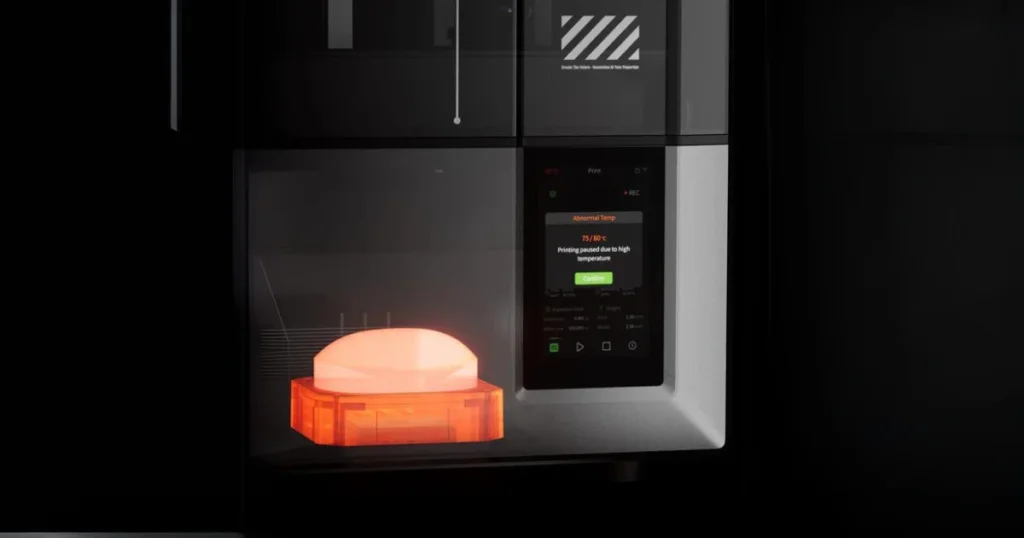
The printer uses three copper heat pipes and a single fan for cooling, which proved adequate even during long print sessions. I monitored the temperature during a 12-hour print run, and it maintained consistent temperatures throughout.
Software Experience
The Elegoo Mars 5 Ultra comes with ChituBox Basic, and while some might see this as a limitation, I found it more than capable for most tasks. The slicer is intuitive, and the integration with the printer’s WiFi features is seamless. You get a 60-day trial of ChituBox Pro included, but honestly, I didn’t find myself needing the premium features for most prints.
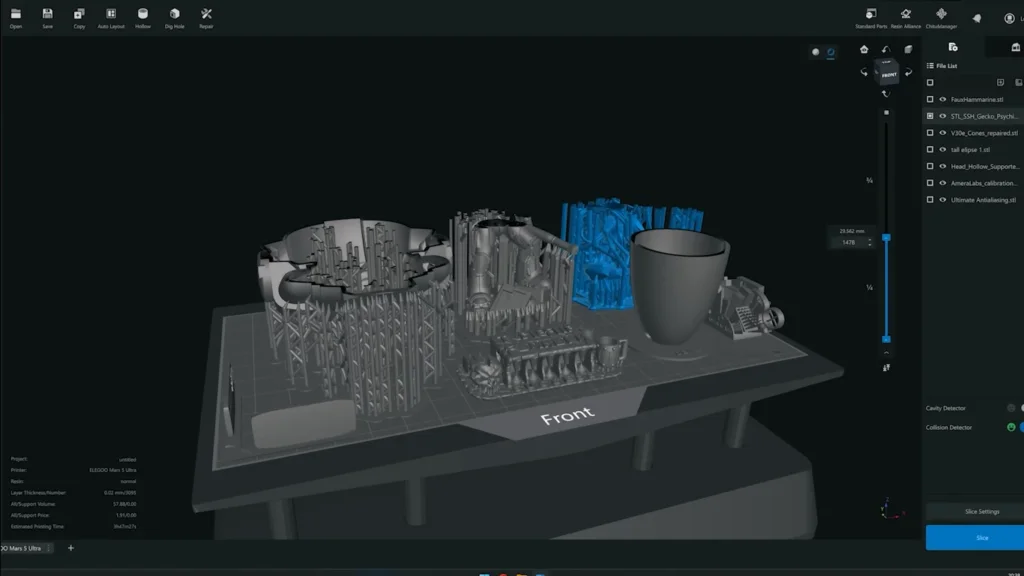
The WiFi implementation deserves special mention. Not only can you transfer files wirelessly, but you can also monitor your prints in real-time through the built-in camera. The time-lapse recording feature is a nice bonus, especially if you’re into sharing your prints on social media.
Elegoo Mars 5 Ultra specification chart
| Specification | Details |
|---|---|
| Build Volume | 153.36 x 77.76 x 165 mm³ |
| Printing Speed | Up to 150 mm/h |
| Resolution | XY: 18 μm (9K) Z-axis: 0.02 mm |
| Printing Technology | MSLA (Masked Stereolithography) |
| LCD Screen | 7-inch 9K Mono LCD |
| Connection | USB, Wi-Fi |
| Slicer Software | Chitubox |
| Power Requirements | 100-240V, 24V 3A |
| Dimensions | 260 x 268 x 451.5 mm |
| Net Weight | 8.8 kg |
| Additional Features | Tilt Release, AI Camera, Power-Loss Resume |
| Warranty and Support | 1-Year Warranty, Lifetime Support |
| Price | Regular: $338.00 USD | Offer: $269.99 USD |
Post-Processing and Maintenance
The Elegoo Mars 5 Ultra’s build plate design features a laser-engraved surface that provides excellent adhesion while making print removal surprisingly easy. The dual pour spouts on the resin vat are a small but welcome feature that made resin handling less messy than with other printers I’ve used.
One minor gripe is that the drip tray, while functional, feels a bit lightweight compared to the rest of the printer’s solid construction. However, it does its job of catching excess resin effectively, and the replaceable lock screws on the resin tank prevent the common issue of resin clogging.
Power Loss Recovery That Actually Works
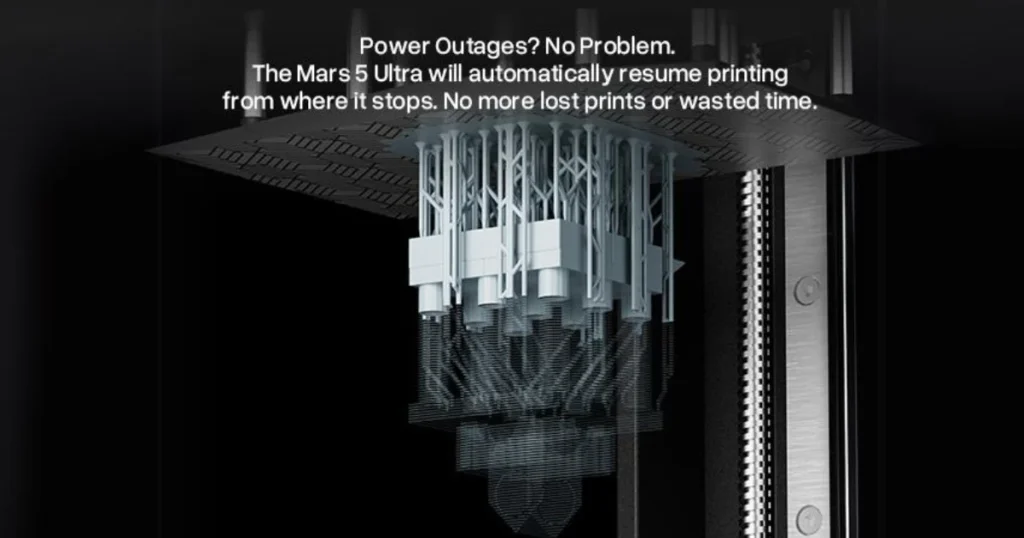
One feature I initially overlooked but came to appreciate during my extended testing was the power loss recovery system. Living in an area with occasional power fluctuations, I’ve seen my fair share of failed prints due to power issues. The Elegoo Mars 5 Ultra handles these situations gracefully – when power returns, it picks up right where it left off. During my testing, I deliberately cut power mid-print (not something I’d typically recommend), and the printer resumed without any visible layer shifting or artifacts in the final print.
The Self-Check System You’ll Actually Use
The printer’s self-check functionality goes beyond basic diagnostics. I particularly appreciated how it tracks the usage of the release film – after about 60,000 cycles, you’ll get a reminder to replace it. This might seem like a small detail, but anyone who’s had a print fail due to worn-out FEP knows how valuable this feature is. I found myself regularly using the one-click self-check before starting longer prints, something I rarely did with other printers.
Advanced Resin Compatibility
While testing different materials, I found the Elegoo Mars 5 Ultra handles a broader range of resins than initially expected. It worked well with water-washable resins, standard resins, ABS-like resins, and even plant-based options. The printer’s advanced temperature management system seems to help maintain consistency across different resin types, though I noticed slightly better results when using the printer in a room temperature environment around 20-25°C.
Cluster Printing Capabilities
One feature I didn’t fully appreciate at first was the printer’s cluster printing ability over WiFi. If you’re running multiple Elegoo Mars 5 Ultras, you can control them all from a single device. I had the opportunity to test this with two units, and the workflow was surprisingly smooth. The real-time monitoring through the AI camera made it feasible to manage multiple prints simultaneously – something that would be nerve-wracking without the automated error detection.
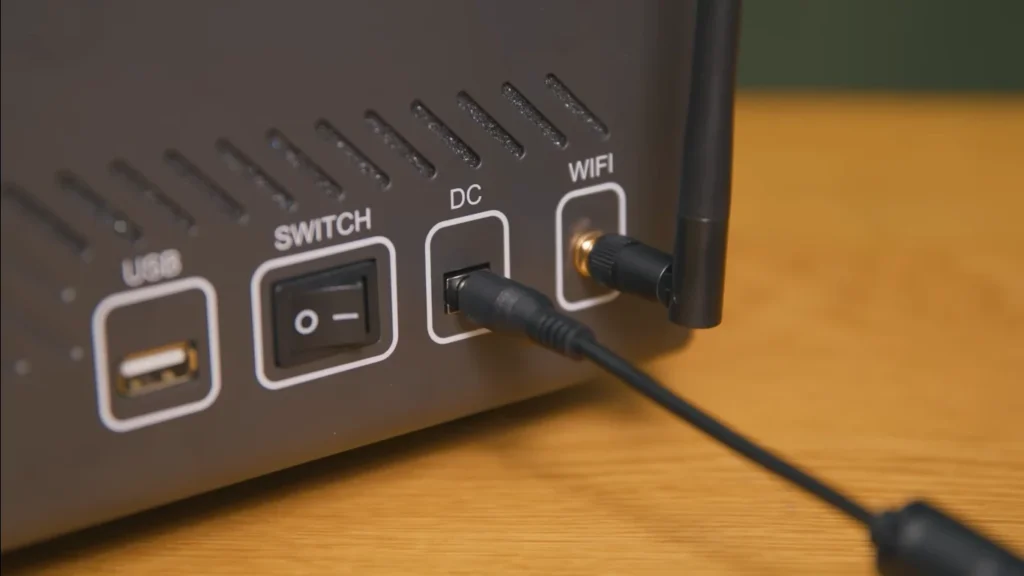
Enhanced Build Plate Design
The build plate deserves special mention for its two-tier design. Initially, I was skeptical about how this would affect print removal, but after dozens of prints, I’ve found it actually helps prevent suction issues while maintaining excellent adhesion. The laser-engraved surface pattern provides consistent results across different resin types, and I haven’t had a single print failure due to adhesion issues.
Air Purification Compatibility
While the Elegoo Mars 5 Ultra doesn’t have built-in air filtration, it’s designed to work with the Mars Mate air purifier. During my testing in a small workspace, I found this compatibility particularly valuable. The purifier’s activated carbon filter claims 95% TVOC reduction, and while I can’t verify that exact number, I noticed a significant reduction in resin odors when using them together.
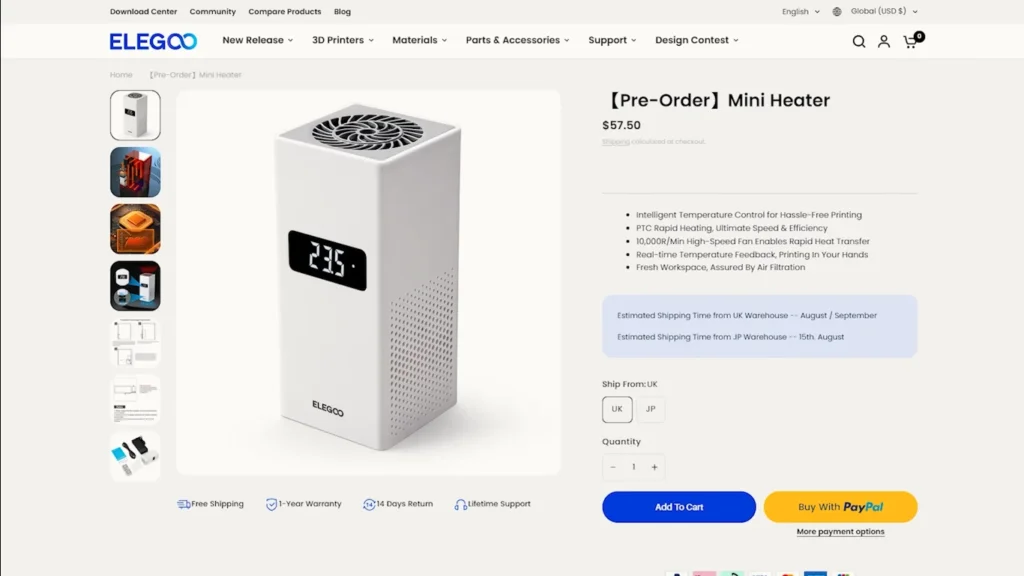
Advanced Temperature Protection
The printer’s temperature management system deserves more attention than I initially gave it. The combination of three copper heat pipes and a single fan might sound basic, but it’s remarkably effective. During a 72-hour continuous printing test, the system maintained stable temperatures throughout. The automatic shutdown at 80°C isn’t just a safety feature – it’s actually saved me from a potentially failed print when my workshop temperature spiked during a summer afternoon.
LCD Screen Protection
The 9H hardness tempered glass protecting the LCD screen has proven more valuable than I initially thought. After accidentally scratching it with a metal scraper (don’t do this at home), I was relieved to find the actual LCD remained unharmed. This level of protection isn’t common in this price range and adds significant value for long-term durability.
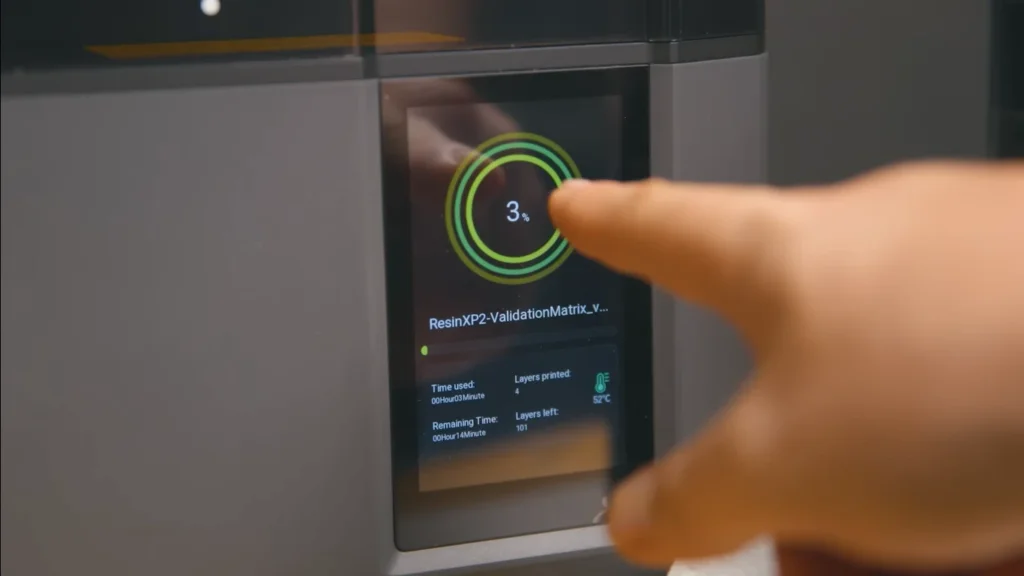
System and Software Integration
The printer runs on EL3D-4.0, Elegoo’s self-developed system with 8GB of ROM. This might not sound exciting, but it results in noticeably faster file transfers and more stable operation compared to earlier models. The system handles large files smoothly, and I haven’t experienced any slicing artifacts or file corruption issues, which can be common with some budget printers.
Language Support and Accessibility
One often-overlooked feature is the comprehensive language support. The printer supports 12 languages, including Chinese, English, Japanese, Dutch, Korean, French, German, Russian, Italian, Spanish, Turkish, and Portuguese. The translations are well-done, making this printer truly accessible to a global audience.
Real-World Applications
After extended testing, I’ve found the Elegoo Mars 5 Ultra particularly excels in certain applications. While it can’t be used for direct dental applications or jeweler’s wax casting, it’s perfect for creating detailed prototypes and models. The precision makes it suitable for architectural models, custom jewelry designs (for lost wax casting), and highly detailed miniatures.

The Remaining Quirks
No printer is perfect, and the Elegoo Mars 5 Ultra does have a few quirks worth mentioning. The USB port placement on the right side can be awkward depending on your workspace setup. The drip tray, while functional, could be more substantial. And while the AI camera is impressive, its field of view can be limited when printing larger objects.
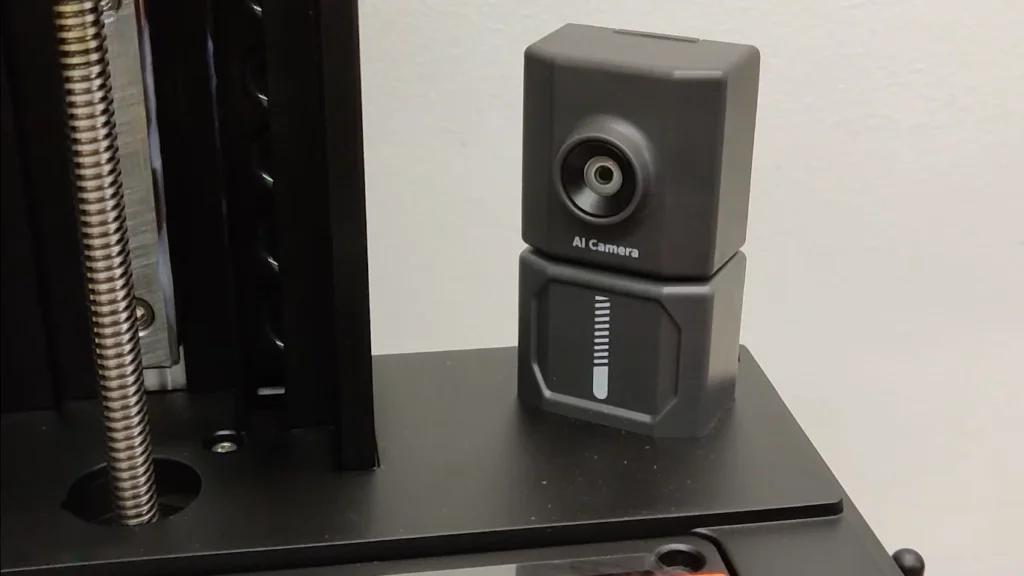
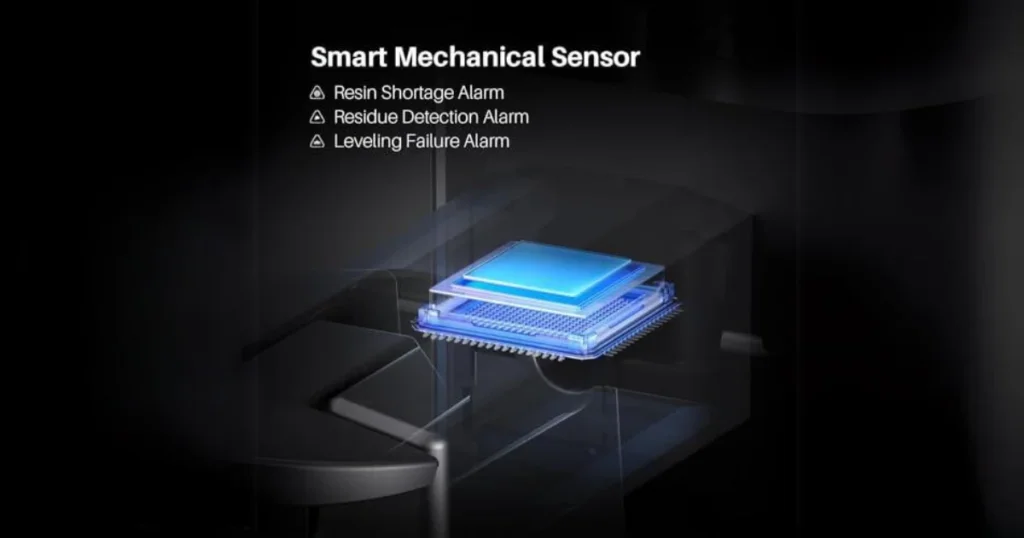
These additional features and observations really round out the full picture of what the Elegoo Mars 5 Ultra offers. While some might seem like minor details, they add up to create a more refined and user-friendly experience than you’d expect at this price point. The attention to detail in these secondary features shows that Elegoo hasn’t just focused on the headline specifications but has thought carefully about the entire user experience.
The Verdict
After weeks of extensive testing, the Elegoo Mars 5 Ultra has proven itself to be a capable and innovative resin printer that offers significant value for its price point. While it’s not perfect – the smaller build volume might limit some users, and the AI camera system still has room for improvement – the core printing experience is excellent, especially for those focusing on detailed miniatures or small functional parts.
At $269.99, the Elegoo Mars 5 Ultra delivers features previously reserved for much more expensive printers. The tilting vat mechanism, 9K resolution screen, and robust build quality make it a compelling choice for both beginners and experienced users looking for a reliable secondary printer. However, for those of you looking to print larger models on a regular basis, the Saturn 4 Ultra is definitely an option as it does provide mostly the same functionality just with an expanded build volume.
The Elegoo Mars 5 Ultra does not attempt to do everything for everyone, and that is one of its strong points. It has a strong sense of self: this is the small, high-resolution resin printer that stresses print quality and user experience instead of increasing build volume. For those who fit into its target audience, it’s an excellent choice that’s easy to recommend.
Based on my experience, absolutely. The auto-leveling feature and straightforward setup process make it remarkably user-friendly. I had mine up and running in under 10 minutes, and the included ChituBox software is intuitive enough that even complete newcomers can start printing quickly. Just remember that like any resin printer, you’ll need to handle liquid resin safely, so factor in the cost of safety equipment like gloves and a mask.
The price difference isn’t just marketing – there are significant upgrades in the Ultra version. While testing both, I found the Ultra’s 9K resolution and tilt release mechanism make a noticeable difference in print quality and speed. The standard Mars 5 is still a capable printer, but if detail and speed matter to you, the Ultra’s advantages are worth the extra cost.
During my testing, I printed everything from detailed miniatures to dental models, and the quality was consistently impressive. While it might not match industrial printers costing thousands more, the 18-micron resolution and reliable performance make it suitable for small business needs, especially in fields like jewelry design or tabletop gaming.
This is where I need to be straight with you – like all resin printers, the Elegoo Mars 5 Ultra does produce odors. While it’s enclosed, I wouldn’t recommend running it in your living space. I tested it with the optional Mars Mate air purifier, which helped significantly, but you’ll still want to ensure good ventilation. My setup in a well-ventilated workspace with the purifier worked perfectly.
Here’s the real deal – while the printer is $269.99 on sale, you’ll need some additional supplies. I spent about $40 on resin, $20 on gloves and masks, $30 on isopropyl alcohol for cleaning, and $20 on basic tools. If you want the Mars Mate air purifier, that’s an additional investment. All in, budget around $400-450 to get fully set up with everything you need.
Nikko Jenkins is a technology journalist based in the US, covering tool reviews and comparisons across North America, Europe and Asia, particularly 3D Printers. His concise, insightful articles on the latest innovations help readers worldwide make informed tech decisions. Jenkins’ expertise and engaging style have made him a respected voice in the global technology landscape.
Feel free to reach out to me at nikkojenkins@360techinsights.com.

